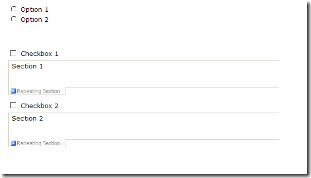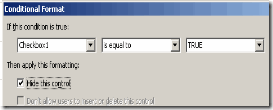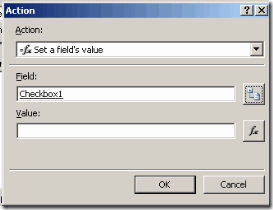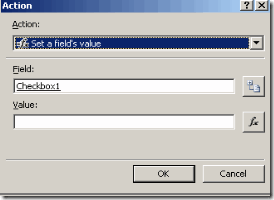
Fig 1: Form
2. Add conditional formatting to Section 1 to hide it when Checkbox 1 is checked.

Fig 2: Conditional formatting for Section 1
3. Add conditional formatting to Section 2 to hide it when Checkbox 2 is checked.
4. Add rule to Option 1. By default, the value of Option button 1 is "1" and value of option button 2 is "2". Name rule "Open Section1" and set condition:

Fig 3: Set condition for Rule "Open Section1"
5. After setting the condition, click "Add Action" button to add action. In the "Field", select "Checkbox1" then click the "fx" button to add formula.

Fig 4: Add Action
6. Use "Insert Function" button to add "boolean" function or write it directly in the formula box. Click "Verify Formula" button to verify the formula and then click "OK".

Fig 5: Add Formula
7. You need to add three more rules. The rules are shared between the two radio buttons. Rules established for any of the buttons, both buttons. Add the second rule of "Close Section 2". Set the following condition:

Fig 6: Set condition for rule "Close Section 2"
Add action for this rule. Select "Checkbox1" in "Field" and leave the value blank. This will uncheck the "Checkbox1".
8. Add third rule "Open Section 2" to open the section 2. Condition set: Options is equal to "2" and add the action: "CheckBox2" has a value "Boolean (" true "). Use the technique described above to add formula. Remember, the formula of writing by hand is not set the Boolean value and will be considered as plain text in InfoPath.
9. Add fourth rule "Close Section 1". Add following condition:

Fig 7: Set condition for rule "Close Section 1"
Add following action:

Fig 8: Add action
Select "CheckBox1" in the "field" and uncheck the value. This disables the "CheckBox1". Remember that the sections are associated with those checkboxes. Checking CheckBox1 display section 1 and unchecking that hides in section 1. Similarly, CheckBox2 display control section 2 and unchecking that hides in section 2.
That's all. The point, in short, is that you must set the value of the box to "blank" to disable. Setting it to "False" is not uncheck.
No comments:
Post a Comment